- For specific countries, see Taxicabs by country.

Taxicab in Bogotá's downtown

Several New York City taxicabs during Midtown rush hour in Manhattan

A green taxi at Arlington, Virginia. Hybrid taxis are becoming common in major cities around the world.
| This article needs additional citations for verification. Please help improve this article by adding citations to reliable sources. Unsourced material may be challenged and removed. (March 2011) |
A taxicab, also taxi or cab, is a type of vehicle for hire with a driver, used by a single passenger or small group of passengers, often for a non-shared ride. A taxicab conveys passengers between locations of their choice. In modes of public transport, the pick-up and drop-off locations are determined by the service provider, not by the passenger, although demand responsive transport and share taxis provide a hybrid bus/taxi mode.
There are four distinct forms of taxicab, which can be identified by slightly differing terms in different countries: hackney carriages, also known as public hire, hailed or street taxis, licensed for hailing on the street; private hire vehicles, also known as minicabs or private hire taxis, licensed for pre-booking only; Taxibuses, also known as Jitneys, operating on pre-set routes typified by multiple stops and multiple independent passengers; and Limousines, specialized vehicle licensed for operation by pre-booking.
Although types of vehicles and methods of regulation, hiring, dispatching, and negotiating payment differ significantly from country to country, many common characteristics exist.
Etymology[]
Harry Nathaniel Allen of The New York Taxicab Co., who imported the first 600 gas-powered New York taxicabs from France, coined the word "taxicab" as a contraction of "taximeter cabriolet". "Taximeter" is an adaptation of the French word taximètre, which is a derivation of the German word taxameter, coined from Medieval Latin taxa, which means tax/charge, together with meter from the Greek metron (μέτρον) meaning measure.[1] A "cabriolet" is a type of horse-drawn carriage.

A taxi sleigh in Vaasa in the 1920s

The back view of a "bicitaxi" (as identified by its license plate) from Ciudad Nezahualcoyotl, Mexico
History[]
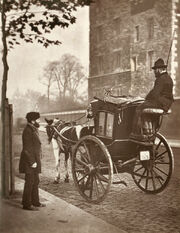
Horse drawn cab, London 1877
Horse-drawn for-hire hackney carriage services began operating in both Paris and London in the early 17th century. The first documented service was started by Nicolas Sauvage in Paris in 1640.[2] His vehicles were known as fiacres, as the main vehicle depot apparently was opposite a shrine to Saint Fiacre. (The term fiacre is still used in French to describe a horse-drawn vehicle for hire, while the German term Fiaker is used, especially in Austria, to refer to the same thing). In London the Hackney Carriage Act (1635) became the first legislated control in English on vehicles for hire. In the 19th century, Hansom cabs largely replaced the older designs because of their improved speed and safety.
The first taxi service in Toronto, "The City", was established in 1837 by Thornton Blackburn, an ex-slave whose escape from Detroit was the impetus for the Blackburn Riot.[3]
Gasoline-powered taxicabs began operating in Paris in 1899, in London in 1903, and in New York in 1907. The New York taxicabs were imported from France by Harry N. Allen. Allen was the first person to paint his taxicabs yellow, after learning that yellow is the colour most easily seen from a distance.[4]
Taxicabs proliferated around the world in the early 20th century. The first major innovation after the invention of the taximeter occurred in the late 1940s, when two-way radios first appeared in taxicabs. Radios enabled taxicabs and dispatch offices to communicate and serve customers more efficiently than previous methods, such as using callboxes. The next major innovation occurred in the 1980s, when computer assisted dispatching was first introduced.[citation needed]
There has generally been a legal struggle concerning the certification of motor vehicles to be taxicabs, which take much more wear than a private car does. In London, they were additionally required to meet stringent specifications (Metropolitan Conditions of Fitness - MCF), adopted in entirety by a number of other large UK cities (including Glasgow and Edinburgh), for example, as concerns turn radius, which resulted for a time in having only one make legally usable.[citation needed]
In the US, in the 1930s, the cabs were often DeSotos or Packards. General Motors offered a specialized vehicle for a time, named the General. The firm Checker came into existence then, and stopped manufacturing cabs in the early 1980s. Its cars were specially built to carry "double dates." But now New York City requires that all taxicabs be ordinary cars. They are mainly long-wheelbase versions of the Ford Crown Victoria. Toyota Sienna minivans are the alternate vehicle of choice in New York's cab fleet. In the 1960s in Europe, Mercedes-Benz and Peugeot offered diesel taxicabs. This form of engine is now the norm in Europe due to its superior fuel economy, torque and reliability.[citation needed]
As emergency transport[]
Taxis played a key part in the First Battle of the Marne. Of the 10,000 French reserve infantry troops ferried from Paris, 6,000 were transported by the 600 strong taxi fleet (7 September 1914).
The Birmingham pub bombings (21 November 1974), which killed 21 people and injured 182, presented emergency services with unprecedented peace time demands. According to eye witness accounts, the fire officer in charge, knowing the 40 ambulances he requested were unlikely to be available, requested the Taxi Owners Association to transport the injured to the nearby Birmingham Accident Hospital and Birmingham General Hospital.[5]

A taxicab in San Francisco

A taxi-boat in Venice, Italy
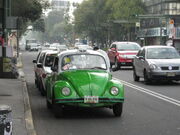
A now phased out VW Beetle taxi in Mexico City. These VW Beetles are commonly referred to as "Vochos"
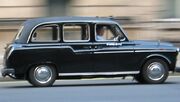
LTI Fairway in London

A Taxi Cab in Montreal
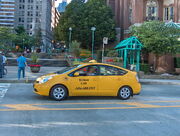
Toyota Prius in Vancouver
Vehicles[]
Taxi service is typically provided by automobiles, but various human-powered vehicles, (such as the rickshaw) and animal-powered vehicles (such as the Hansom cab) or even boats (such as water taxies or gondolas) are also used or have been used historically. In Western Europe, Bissau, and to an extent, Australia, it is not uncommon for expensive cars such as Mercedes-Benz to be the taxicab of choice. Often this decision is based upon the perceived reliability of, and warranty offered with these vehicles. These taxi-service vehicles are almost always equipped with four-cylinder turbodiesel engines and relatively low levels of equipment, and are not considered luxury cars. This has changed though in countries, such as Denmark, where tax regulation make it profitable to sell the vehicles after a few years of service, which requires the cars to be well equipped and kept in good condition.[citation needed]
Australia and New Zealand[]
Traditionally in Australia, taxicabs are mainly Ford Falcons.[citation needed] There are premium operators who mainly operate on Ford Fairlanes and Holden Statesman/Caprices. Almost all Australian taxicabs run on liquefied petroleum gas. More recently, the Chrysler 300C Turbo Diesel and BMW 5-series diesel have been introduced to replace the phased out Fairlane. The Toyota Prius is also used in metropolitan areas. There are also "Maxi Taxis" which mostly are for-hire minibuses. Toyota Hiaces, Volkswagen Multivans and Mercedes-Benz Vitos are typically used.
In New Zealand, as in Australia, Holden Commodores and Ford Falcons were the traditional taxicab of choice. However, in the last decade large front wheel drive V6 models such as Toyota Avalons, Nissan Maximas and Toyota Camrys predominated. In the main centres these are now being replaced by lower carbon-emission vehicles, primarily the Toyota Prius.
At the other end of the scale, the traditional "Corporate cabs" such as Ford Fairlanes and Holden Statesman/Caprices are now becoming obsolete. As in other countries, suitable replacements for these traditional livery service vehicles are unclear.
India[]
In India, the most common taxis are Premier Automobiles (Fiat), Maruti Omni, Tata Indica and Hindustan Ambassador. Small LPG auto-rickshaws are more commonly used in the suburbs. Recently Toyota Innova are becoming more common and Toyota Corolla for more of a luxurious ride.
In Mumbai, most hailable taxis can be easily identified by their black and yellow color scheme. Newer air conditioned taxis (Cool Cabs) are blue, and are typically only available on a pre-booked basis.
Indonesia[]
Indonesian taxicabs operate Toyota Limos and Hyundai Accents. Silver Bird VIP taxicabs operate Toyota Crowns and provide Mercedes-Benz S-Classes and E-classes that are sometimes for rent. Traditional Indonesian taxis are special hooded rickshaws driven from the back called becaks which are often used in smaller cities such as Surabaya and Yogyakarta."Auto rickshaws", called bajais, provide local transportation in the back streets of some parts of Jakarta and other cities.
Ireland[]
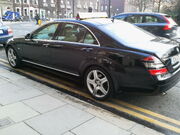
A Mercedes S600L taxi in Dublin, Ireland
The Mercedes-Benz E-Class and S-Class are popular models for use as taxis in Ireland.
Mexico[]
In Mexico, Mexico City's ubiquitous VW Type 1 (Beetle) cabs were green and white (being firstly yellow) by law until early 2003. No VWs are coloured this way anymore. Matchbox released a scale model of the VW taxi in 2004, numbered 31, also known as a bocho. However, the two-door Volkswagens have largely been displaced by more suitable four-door sedans, the Nissan Tsuru, a Sentra MkIII (B13) based saloon. Other taxis can range from Fords to Mercedes-Benzes, with the most common being Taurus, Chevy hatchbacks (a re-badged Opel Corsa), and Volkswagen Pointers. With this reform came a new color scheme (Maroon and Gold, with images of the Angel de la Independencia) and more stringent requirements for documentation. Official taxis now must present a large green-colored license in the back left window, which contains the driver's name, photo and permission to operate a taxi. There are also many taxicab bus models known as peseros as the original taxi service began in Mexico City charged only one peso.
Norway[]
In Norway, the end of year 2009 roster showed that 41.9% of the 8961 taxicabs were from Mercedes-Benz, and several manufacturers that can offer a diesel-engined executive car are represented. 91.6% of Norwegian taxis are equipped with diesel engines. Among "maxitaxis" (minibuses operating as taxis), Mercedes-Benz vehicles such as the Mercedes-Benz Sprinter constitute 70% of the fleet.[6] The Mercedes-Benz E-classes is the most common new cab, with the hybrid Toyota Prius in second place, the latter having increased its sales due to the tax regime favoring low carbon dioxide emissions.[7]
Romania[]
In Romania the car most used as a taxi is the Dacia Logan, more comfortable than other cars but charging a higher rate. Taxi drivers are well paid. The Dacia Logan was modified inside and has a computer that calculate miles. Also used as taxis are the Chevrolet Spark (rarely), Dacia Sandero and others.
Singapore[]
- See also: Taxicabs of Singapore#Vehicle types
In Singapore, Toyota Comforts (rebadged as Crowns) and Hyundai Sonatas are most common, while there are also Nissan Cedrics, Toyota Coronas (now phased out), Volkswagen Tourans, Mercedes-Benz E-Classes, Honda Airwaves, Toyota Wishes, Škoda Superbs, Kia Magentis and brand new LPG Toyota Priuses to conserve fuel.There are also other cabs which charge higher booking rates, for example the Chrysler 300C and the Maxicab and Space taxi, which are Mercedes-Benz Vitos and Ssangyong Stavic/Rodiuses respectively. The Nissan Cedric will be phased out and Chevrolets will replace them.
Spain[]
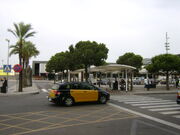
Taxicab in Barcelona, Spain
In Spain, the most common taxi cars in Spain are SEAT Toledos, Opel Vectras, Škoda Octavias, Peugeot 406es and Volkswagen Jettas. You may also find MPV models such as Fiat Ulysses, SEAT Alhambras, SEAT Altea XLs or Kia Carnivals, which are sometimes also adapted to carry wheelchair passengers.
Trinidad and Tobago[]
In Trinidad and Tobago the vehicles most commonly used as taxis are fifth generation Nissan Cedrics, fifth and sixth generation Nissan Laurels, 6th to 8th generation Toyota Crowns and any other vehicles registered with an "H". However in Trinidad, many cars still operate as taxicabs even without being registered. These "illegal" taxicabs are called "PH"[8] or "P/H" taxis due to the fact that private cars are registered with a "P" for example, "PAU 6767". Private taxi companies are scarce and expensive, hence all taxis in Trinidad are both driver managed and driver operated. These privately owned taxis vary in colour and model, therefore one would almost never see a "Yellow cab" in Trinidad and Tobago. Unlike Maxi taxis that are colour coded to a specific area, taxicabs are not colour coded.
United Kingdom[]
In the United Kingdom a current debate exists as to the most appropriate vehicles to be licensed as taxis. Local authorities split between those that adopt the Metropolitan Conditions of Fitness, which are widely interpreted to require London style Black taxis (Austin FX4, TX1, TXII, TX4), and those that allow a wider range of vehicles. The debate is informed, but not solved, by a desire to implement accessible taxis, defined and required under the Disability Discrimination Act (1985), but not enforced in all authority areas. UK devolved administrations (Scotland, Northern Ireland, and Wales) have devolved responsibilities for taxi licensing law (but not for application, which is enforced at a local authority level). Scotland can, but chooses not to, determine a national vehicle standard. Northern Ireland, which operates as a single authority under the Department of the Environment for Northern Ireland, operates a four vehicle structure. All UK Taxies display a taxi license plate with a unique number and the vehicles license number & breif description of the model & colour (to stop Taxi licence plates being put on any vehicle & using it as a taxi) as every vehicle must be licensed by the local authority. Some areas also restrict the number of licenses issued.
United States and Canada[]
The most common taxi car in the United States and Canada is the Ford Crown Victoria, as well as the Lincoln Town Car. They both offer a spacious interior and V8 engines. The Crown Victoria is slowly being phased out by both taxi companies and The Ford Motor Company. Toyota Camry is becoming popular in Canada, especially in Toronto. More fuel efficient and Hybrid taxis are beginning to become more common in North America, such as the Toyota Camry hybrid, Toyota Prius hybrid, Ford Escape hybrid and Honda Civic hybrid. Historically, the purpose-built cars made by the Checker Motors Corporation were the iconic U.S. cab.
Guyana[]
In Guyana taxis are most commonly Toyota Carinas, Toyota Corollas, and Nissan Laurels. Any vehicle registered with the first letter as "H" is a taxi. There are over 20000 registered taxis in the country. Some cars are not registered to be taxis but still operate as them. They are called Private Hire cars and operate illegally in the country. They have "P" plates and are not authorised to operate as a taxi, they are private cars eg"PNN 1515". As of 2010 taxis are required to be painted yellow. They also have a sticker on the rear bumper that reads Hackney Carriage.
Wheelchair-accessible taxicabs[]
| This section does not cite any references or sources. Please help improve this article by adding citations to reliable sources. Unverifiable material may be challenged and removed. (July 2011) |
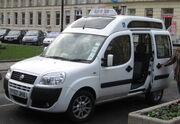
A wheelchair-adapted taxi in Cheltenham, UK
In recent years, some companies have been adding specially modified vehicles capable of transporting wheelchair-using passengers to their fleets. Such taxicabs are variously called accessible taxis, wheelchair- or wheelchair-accessible taxicabs, modified taxicabs, and so on.
Wheelchair taxicabs are most often specially modified vans or minivans. Wheelchair-using passengers are loaded, with the help of the driver, via a lift or, more commonly, a ramp, at the rear of the vehicle.This feature is however a subject for concern amongst Licensing Authorities who feel that the wheelchair passenger could not easily exit the vehicle in the event of accident damage to the rear door.The latest generation of accessible taxis features side loading with emergency egress possible from either of the 2 side doors as well as the rear. The wheelchair is secured using various systems, commonly including some type of belt and clip combination, or wheel locks. Some wheelchair taxicabs are capable of transporting only one wheelchair-using passenger at a time, and can usually accommodate 4 to 6 additional able-bodied passengers.
Wheelchair taxicabs are part of the regular fleet in most cases, and so are not reserved exclusively for the use of wheelchair users. They are often used by able-bodied people who need to transport luggage, small items of furniture, animals, and other items. Because of this, and since only a small percentage of the average fleet is modified, wheelchair users must often wait for significantly longer periods when calling for a cab, and flagging a modified taxicab on the street is much more difficult.
These particular taxicabs have developed their own special names such as, 'Maxicabs'.
Other[]
Taxicabs in less developed places can be a completely different experience, such as the antique French cars typically found in Cairo. However starting March 2006, newer modern taxicabs entered the service operated by various private companies. Taxicabs differ in other ways as well: London's black cabs have a large compartment beside the driver for storing bags, while many fleets of regular taxis also include wheelchair accessible taxicabs among their numbers (see below). Although taxicabs have traditionally been sedans, minivan and even SUV taxicabs are becoming increasingly common. In many cities, limousines operate as well, usually in competition with taxicabs and at higher fares.
Recently, with growing concern for the environment, there have been solar powered taxicabs. On April 20, 2008, a "solar taxi tour" was launched that aimed to tour 15 countries in 18 months in a solar taxi that can reach speeds of 90 km/h with zero emission. The aim of the tour was to spread knowledge about environmental protection.[9]

ClubTaxi and the Karaoke Cabs in Dallas, Texas
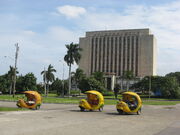
Three-wheeled Coco taxis in Havana, Cuba
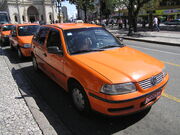
Taxis in Curitiba, Brazil.
Livery[]
- Main article: Livery of taxicabs worldwide
Hiring[]
- See also: Taxi stand
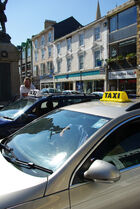
Some taxis waiting for a customer in Truro, England
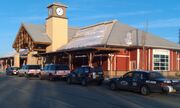
Taxicabs lined up in front of the Alaska Railroad depot in Fairbanks, Alaska, USA.
Most places allow a Taxi to be "hailed" or "flagged" on the side of the street as it is approaching. Another option is a taxi stand (sometimes also called a "cab stand", "hack stand", "taxi rank" or "cab rank"). Taxi stands are usually located at airports, railway stations, major retail areas (malls), hotels and other places where a large number of passengers are likely to be found. In some places—Japan, for example—taxi stands are arranged according to the size of the taxis, so that large- and small-capacity cabs line up separately. The taxi at the front of the line is due (barring unusual circumstances) for the next fare.
In the United States, a nut is industry slang for the amount of money a driver has to pay upfront to lease a taxi for a specific period of time. Once that amount is collected in fare, the driver then begins to make a profit. A driver "on the nut" is trying to earn back the initial cost. This varies from city to city though, in Las Vegas, Nevada, all taxicabs are owned and operated by the companies and all drivers are employees (hence no initial cost and earn a percentage of each fare). So "on the nut" simply means to be next in a taxi stand to receive a passenger.
Passengers also commonly call a central dispatch office for taxis. In some jurisdictions private hire vehicles can only be hired from the dispatch office, and must be assigned each fare by the office by radio or phone. Picking up passengers off the street in these areas can lead to suspension or revocation of the driver's taxi license, or even prosecution and a large fine.
Other areas may have a mix of the two systems, where drivers may respond to radio calls and also pick up street fares.
Dispatching[]
| This section does not cite any references or sources. Please help improve this article by adding citations to reliable sources. Unverifiable material may be challenged and removed. (December 2010) |
The activity of taxi fleets is usually monitored and controlled by a central office, which provides dispatching, accounting, and human resources services to one or more taxi companies. Taxi owners and drivers usually communicate with the dispatch office through either a 2-way radio or a computer terminal (called a mobile data terminal). Before the innovation of radio dispatch in the 1950s, taxi drivers would use a callbox—a special telephone at a taxi stand—to contact the dispatch office.
When a customer calls for a taxi, a trip is dispatched by either radio or computer, via an in-vehicle mobile data terminal, to the most suitable cab. The most suitable cab may either be the one closest to the pick-up address (often determined by GPS coordinates nowadays) or the one that was the first to book in to the "zone" surrounding the pickup address. Cabs are sometimes dispatched from their taxi stands; a call to "Top of the 2" means that the first cab in line at stand #2 is supposed to pick someone up.
In offices using radio dispatch, taxi locations are often tracked using magnetic pegs on a "board"—a metal sheet with an engraved map of taxi zones. In computerized dispatch, the status of taxis is tracked by the computer system.
Taxi frequencies are generally licensed in duplex pairs. One frequency is used for the dispatcher to talk to the cabs, and a second frequency is used to the cabs to talk back. This means that the drivers generally cannot talk to each other. Some cabs have a CB radio in addition to the company radio so they can speak to each other.
In the United States, there is a Taxicab Radio Service with pairs assigned for this purpose. A taxi company can also be licensed in the Business Radio Service. Business frequencies in the UHF range are also licensed in pairs to allow for repeaters, though taxi companies usually use the pair for duplex communications.
Some companies don't operate their own radio system and instead subscribe to an Specialized Mobile Radio system. The conventional radios are most suited to companies that operate within the local area and have a high volume of radio traffic. The SMR is more commonly used by black car services that cover a wider area, and smaller companies who use less airtime and don't want to run their own radio systems. With the advent of public data networks in the 1990s, operators are beginning to use PDAs and advanced mobile phones for dispatching and tracking functions in lieu of the traditional radio. Some small car services don't use a dispatcher at all. Instead the customers' calls are forwarded to the cell phones of whichever drivers are on duty at the time.
Fares[]
| This section does not cite any references or sources. Please help improve this article by adding citations to reliable sources. Unverifiable material may be challenged and removed. (July 2011) |
For the distance travelled, the fare for a taxi is usually higher than for other forms of public transport (bus, tram, metro, minicab, train, bike). The fare is not based on the number of people travelling together in a taxi unless it is a 'maxi-taxi' (which can carry up to 8 people). Another system is one where more than one customer shares the same taxi and fares are per person. Fares are usually calculated according to a combination of 4 elements: Tariff rate, Initial flagfall or meter drop, distance and waiting time. A taximeter calculates this automatically ("meter" for short and the origin of the word "taxi"). Instead of a metered fare, passengers sometimes pay a flat fare. In some areas, when demand is high—for instance, late at night—a taxi driver may pick up the customer offering the highest bid (this practice may be against the law).
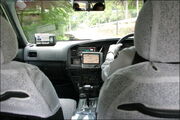
The inside of a Japanese taxicab in Kyoto with GPS navigation on board
[]
Most experienced taxi drivers who have been working in the same city or region for a while would be expected to know the most important streets and places where their customers request to go. However, to aid the process of manual navigation and the taxi driver's memory (and the customer's as well at times) a cab driver is usually equipped with a detailed roadmap of the area in which they work. There is also an increasing use of GPS driven navigational systems in the more wealthy countries around the world.
In London, despite the complex and haphazard road layout, such aids have only recently been employed by a small number of 'black cab' taxi (as opposed to minicab) drivers. Instead, they are required to undergo a demanding process of learning and testing called The Knowledge. This typically takes around three years and equips them with a detailed command of 25,000 streets within central London, major routes outside this area, and all buildings and other destinations to which passengers may ask to be taken.[10]

A hybrid taxi from EnviroCAB, which is part of the environmentally friendly all-hybrid taxi fleet promoted through the Fresh AIRE program in Arlington, Virginia.
Environmental concerns[]
Taxicabs have been both criticized for creating pollution and also hailed as an environmentally responsible alternative to private car use.[11]
The results, published in the journal Atmospheric Environment in January 2006, showed that the level of pollution that people are exposed to differs according to the mode of transport that they use. The most risky method of transport was the back seat of a taxicab, followed by travelling by bus, cycling, walking, with a private car exposing people to the lowest amount of pollution.[12]

A Brazilian Fiat Siena Tetrafuel taxi in São Paulo. It runs as a flexible-fuel or as a bi-fuel with CNG.

New York City hybrid taxicab - Toyota Prius
Alternative fuels and propulsion[]
- Main article: Hybrid taxi
In Australia, nearly all taxis run on LPG, as well as the growing fleet of hybrids.[citation needed] Argentina and the main cities of Brazil have large fleets of taxis running on natural gas. Many Brazilian taxis are flexible-fuel vehicles running on sugarcane ethanol, and some are equipped to run on either natural gas or as a flex-fuel. At least two Brazilian car markers sell these type of bi-fuel vehicles.[13][14][15]
San Francisco became in 2005 one of the first cities to introduce hybrids for taxi service, with a fleet of 15 Ford Escape Hybrids, and by 2009 the original Escape Hybrids were retired after 300,000 miles per vehicle.[16] In 2007 the city approved the Clean Air Taxi Grant Program in order to encourage cab companies to purchase alternative fuel vehicles, by providing incentives of USD2,000 per new alternative fuel vehicle on a first-come, first-served basis.[17][18] Out of a total of 1,378 eligible vehicles (wheelchair accessible taxi-vans are excluded) 788 are alternative fuel vehicles, representing 57% of the San Francisco's taxicab fleet by March 2010. Gasoline-electric hybrids accounted for 657 green taxis and compressed natural gas vehicles for 131.[17][18][19]
As of mid 2009 New York City had 2,019 hybrid taxis and 12 clean diesel vehicles,[20] representing 15% of New York's 13,237 taxis in service, the most in any city in North America. At this time owners began retiring its original hybrid fleet after 300,000 and 350,00 miles per vehicle.[16][21] Two attempts by the Bloomberg Administration to implement policies to force the replacement of all New York's 13,000 taxis for hybrids by 2012 have been blocked by court rulings.[22][23]
Chicago is following New York City's lead by proposing a mandate for Chicago's entire fleet of 6,700 taxicabs to become hybrid by 1 January 2014. As of 2008 Chicago's fleet had only 50 hybrid taxicabs.[24] In 2008 Boston mandated that its entire taxi fleet must be converted to hybrids by 2015.[25] Arlington, Virginia also has a small fleet of 85 environmentally friendly hybrid cabs introduced in early 2008. The green taxi expansion is part of a county campaign known as Fresh AIRE, or Arlington Initiative to Reduce Emissions, and included a new all-hybrid taxi company called EnviroCAB, which became the first all-hybrid taxicab fleet in the United States, and the first carbon-negative taxicab company in the world[26][27][28] A similar all-hybrid taxicab company, Clean Air Cab, was launched in Phoenix, Arizona in October 2009.[28]
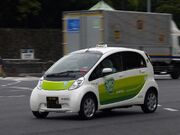
ZeRO TAXI, Mitsubishi i MiEV taxicab in Tokyo.
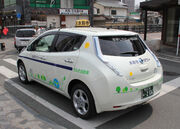
Kumamoto City incorporated the Nissan Leaf electric car to its taxi fleet in February 2011
In Japan, electric taxicabs are becoming increasingly popular. In 2009, battery-swap company Better Place teamed with the Japanese government to trial a fleet of electric taxis with the Better Place battery-swap system in Yokohama.[29] In 2010, the taxi company Hinomaru Linousine Company launched two Mitsubishi i MiEV electric taxicabs in Tokyo. Both taxicabs had female drivers and were branded under ZeRO TAXI livery.[30]
Hybrid taxis are becoming more and more common in Canada, with all new taxis in British Columbia being hybrids, or other fuel efficient vehicles, such as the Toyota Prius or Toyota Corolla. Hybrids such as the Ford Escape Hybrid are slowly being added to the taxicab fleet in Mexico City.[citation needed]
Other cities where taxi service is available with hybrid vehicles include Tokyo, London, Sydney, and Rome.[31] Seoul introduced the first LPI hybrid taxi in December 2009. The internal combustion engine runs on liquefied petroleum gas (LPG) as a fuel.[32]
In 2010 Beijing, China introduced electric taxis. A trial run began in March, 2010 with taxis being cheaper than their regular gasoline counterparts.[33]
Regulation[]
Benefits of liberalization[]
According to theoretical and empirical studies, taxicab deregulation causes the following benefits:[34]
- lower prices, because more taxis are competing on the market; [34]
- lower operating costs, incentivized by the competition; [34]
- the competition adds quality and the pressure to enhance one's reputation; [34]
- new innovations such as shared-ride markets and special services for the disabled, new market niches; [34]
- the demand for taxi services increases, as the prices fall and the quality improves. [34]
Usually the service level increases most in the poorest sections of the city. The effect is highest in peak hours and bad weather, when the demand is highest. [34]
In New Zealand taxi deregulation increased the supply of taxi services and decreased the prices remarkably in big cities, whereas the effects in smaller cities were small. [35]
In Ireland, taxi deregulation decreased waiting times so much that the liberalization became very popular among the public. The number of companies was increased and the quality of cars and drives did not fall. Irish experiences suggest that the regulation should be completely abolished immediately, not just cut down. [36]
Research usually ignores other benefits of liberalization such as:[37]
- black market taxis become legal, possibly eliminating their problems, [37]
- cities save money, as they do not have to plan and enforce regulation. [37]
In almost all deregulating cities the number of taxis increased, more people were employed as drivers, and apparently needs were better satisfied.[36]
Minorities[]
Immigrants and other poor minorities suffer most from taxi regulation, because the work requires relatively little education. Regulation makes entrance to the taxi business particularly difficult for them. [38]
The elderly, disabled, housewives and poor use taxis more often than others. [34]
Opposition to liberalization[]
Rent seeking and bureaucratic self-interest currently dominate the making of taxi-market policy. Existing companies try to limit competition by potential new entrants. For example, in New York City the monopoly advantage for taxi licence holders was $590 million in the early 1980s. The city has 1400 fewer licences than in 1937. The main losers are the carless poor and the disabled. [39]
Taxi owners form a strong lobby network that marginalizes drivers and taxi users. It also pays to corrupt the officials to uphold regulation. [40]
The regulators usually do not wish to rise against the taxi-owner lobby.[41] The politicians do not want taxi drivers to have a negative opinion of them.[42]
Speciously increased complaints[]
Black market taxis often have problems, but illegal customers cannot complain to the police or media. Therefore deregulation may bring more complaints to the public media. In reality, one can expect that when these taxis become legal, their behavior will improve. [37]
The myth on harms of liberalization[]
Taxi companies have a strong incentive to oppose liberalization. According to the study by Kitch, Isaacson and Kasper, the companies have therefore created a myth that in competition taxi companies would be irresponsible and unstable. This claim ignores the U.S. free taxi competition up to 1929. [43]
Taxi companies claim that deregulation would cause problems, raise prices and lower service level on certain hours or in certain places.
Partial deregulation[]
Many U.S. cities have kept on regulating prices and services while allowing for free entrance to taxi business, and prevented market mechanisms from solving information problems. Therefore, new entrants have found it difficult to win new customers using new services or cheap prices. Also, ride-sharing has often been prohibited. [44]
Often officials have also prohibited pricing that would have made short rides in sparsely-populated areas profitable. Thus drivers have refused to take such customers. Therefore, partial deregulation is not always enough to enhance the situation. [44] In one study the problem was that deregulation was applied to a too small area.[36]
In the taxi regulation report by U.S. FTC it was concluded that there are not grounds for limiting the number of taxi companies and cars. These limitations cause a disproportionate burden on low income people. Moreover, it is better to increase the pay for unprofitable areas than to force the taxis to serve these areas. [45]
According to the report, the experience on free entry and price competition are mainly positive: prices have fallen, waiting times were shortened, the market shares of the biggest companies have fallen, and city councils have saved time from licensing and fare setting. However, the airports should either set their own price ceilings or allow for price competition by altering the queue system. [45]
Addressing problems[]
If some problem exists, according to Moore and Rose it is better to address the problem directly instead of regulating the number of taxi licences. For example, if the regulators want to increase safety, they should make safety statutes or publish a public list of safe taxi operators. [46]
Information problems[]
If officials want to regulate prices, they should standardize the measures rather than command prices. For example, they may require that any distance tariffs are set for the first 1/5 miles and then for every subsequent 1/3 miles, to make it easier to compare the prices of different taxis. They should not prohibit other pricing than distance pricing. [44]
It is questionable whether regulation can add welfare, because regulators only have a very limited information on the market. [43]
Airport taxis[]
If an airport regulates prices for taxis in its taxi queues, such regulation has fewer disadvantages than city-wide regulation. An airport may determine prices or organize different queues for taxi services of different qualities and prices. It can be argued whether rules set by the owner of an airport are regulation or just a business model. [44]
Corruption[]
According to Samuel R. Staley, taxi regulation causes corruption. In Washington D.C. 39 people were accused of bribery. When the city started to restrict the number of taxis, taxi companies allegedly started to bribe the officials. [40]
The incentive for this is high. When the number of taxies is restricted, it immediately produces additional value ("monopoly rent") for every existing taxi licence. Many companies have won millions overnight this way. In New York City companies sell their licences for $0.5 million each. [40]
International Trade Association[]
Established in 1917, the Taxicab, Limousine & Paratransit Association (TLPA) is a non-profit trade association of and for the private passenger transportation industry. The membership spans the globe to include 1,100 taxicab companies, executive sedan and limousine services, airport shuttle fleets, non-emergency medical transportation companies, and paratransit services.
In April 2011, TLPA announced their nationwide "Transportation on Patrol" initiative. The TOP program gives local police departments the materials they need to train volunteer taxi drivers to be good witnesses and watch out for criminal behavior.[47]
See also[]
|
|
References[]
- Notes
- ↑ taximeter, The American Heritage Dictionary of the English Language: Fourth Edition, Bartleby, 2000
- ↑ Web-page (in French) at http://www.herodote.net/histoire/evenement.php?jour=18260810 (retrieved 13 June 2008)
- ↑ (2007) I've Got a Home in Glory Land: A Lost Tale of the Underground Railroad. Farrar, Straus and Giroux. ISBN 978-0-374-16481-2. ISBN 978-0-374-53125-6. Winner, 2007 Governor General's Literary Award for Nonfiction; Nominee (Nonfiction), National Books Critics Circle Award 2007. See, Governor General's Award for English language non-fiction.
- ↑ http://www.straightdope.com/columns/read/180/why-does-every-city-seem-to-have-a-yellow-cab-company
- ↑ Alan Stuart Hill, FIFireE. "Birmingham Pub Bombings, November 21, 1974". Retrieved on 5-4-2010.
- ↑ "Bestanden av taxikjøretøy pr 31.12.2009" (in Norwegian). Norges Taxiforbund. Retrieved on 20 January 2011.
- ↑ Merg, Per Morten; Hattrem, Hanne (27 October 2010). "Hybridbil rykker opp mot taxi-toppen" (in Norwegian), VG. Retrieved on 20 January 2011.
- ↑ http://speakouttnt.com/2009/03/attic-supports-crackdown-on-illegal-ph-taxis/
- ↑ Swiss teacher starts China leg of global solar taxi tour. Xinhua News.
- ↑ "The Knowledge Boys", Scientific American Frontiers
- ↑ http://www.nyc.gov/html/tlc/downloads/pdf/taxi_book.pdf "Taxi 07 Roads Forward", page 135
- ↑ "Taking A Taxi Could Increase Your Exposure To Pollution", Science Daily, 11 January 2006
- ↑ Christine Lepisto (2006-08-27). "Fiat Siena Tetra Power: Your Choice of Four Fuels". Treehugger. Retrieved on 2008-08-24.
- ↑ "Nouvelle Fiat Siena 2008: sans complexe" (in French). Caradisiac (2007-11-01). Retrieved on 2008-08-31.
- ↑ GNVNews (November 2006). "Montadores Investem nos Carros á GNV" (in Portuguese). Institutio Brasileiro de Petroleo e Gas. Retrieved on 2008-09-20.
- ↑ 16.0 16.1 "Ford's US Hybrid Sales Up 73% for First 9 Months of 2009; Total US Hybrid Sales Down 14% for Same Period". Green Car Congress (2009-10-14). Retrieved on 2009-10-17.
- ↑ 17.0 17.1 "Halfway to a Green Taxi Fleet in San Francisco". HybridCars.com (2010-03-22). Retrieved on 2010-04-12.
- ↑ 18.0 18.1 "Mayor Newsom Announces That More Than Half of San Francisco's Taxi Fleet is Alternative Vehicles". San Francisco's Office of the Mayor (Press release) (2010-03-22). Retrieved on 2010-04-12.
- ↑ "More than half of taxis now green, Newsom says", San Francisco Chronicle (2010-03-23). Retrieved on 2010-04-12.
- ↑ William Newman (2009-03-29). "Panel Enacts Incentives for Hybrids in Cab Fleets", New York Times. Retrieved on 2010-04-14.
- ↑ Fred Gober. "Hybrid taxis slowly catching on in the west". Infotaxi. Retrieved on 2009-10-17.
- ↑ Sewell Chan (2008-10-31). "Judge Blocks Hybrid Taxi Requirement", New York Times. Retrieved on 2010-04-14.
- ↑ Michael M. Grynbaum (2009-09-30). "Federal Bill Would Clear Way for Green Taxi Fleet", New York Times. Retrieved on 2010-04-14.
- ↑ "City Council Wants All-Hybrid Taxi Fleet By 2014". CBS Chicago (2008-06-12). Retrieved on 2009-10-25.[dead link]
- ↑ "Boston's taxi fleet to go hybrid by 2015", The Boston Globe (2008-08-29). Retrieved on 2009-10-17.
- ↑ "EnviroCAB Launches in Greater Washington, D.C. Area To Become Nation’s First ‘Green’ Taxi Fleet". EnviroCAB Press Release (2008-02-11). Retrieved on 2011-07-14.
- ↑ Downey, Kirstin (2007-09-07). "Arlinton County: Board Gives Go-Ahead to Eco-Friendly Taxicabs", The Washington Post. Retrieved on 2009-10-17.
- ↑ 28.0 28.1 "All-Hybrid Taxi Fleet Debuts in Sunny Phoenix". GreenBiz (2009-10-20). Retrieved on 2010-07-10.
- ↑ http://green.autoblog.com/2009/08/26/better-place-to-trial-battery-swapping-taxis-in-tokyo/
- ↑ http://green.autoblog.com/2010/03/21/mitsubishi-i-mievs-to-become-taxis-in-tokyo/
- ↑ "Trend Watch: Taxis Go Green to Save Cash, Emissions, and Oil". Greencar.com (2009-03-29). Retrieved on 2009-10-17.
- ↑ Seoul Metropolitan Government, PRNE (2009-12-17). "Eco-Friendly Hybrid Taxi Introduced in Seoul". PR Hub. Retrieved on 2010-04-13.
- ↑ "Electric Taxis Begin Trial Run on Beijing's Roads". eChinacities (2011-03-04). Retrieved on 2011-03-07.
- ↑ 34.0 34.1 34.2 34.3 34.4 34.5 34.6 34.7 Do Economists Reach a Conclusion on Taxi Deregulation?, Moore, Adrian T and Ted Balaker. Volume (Issue) 3(1):109-132, January 2006, pages 109,111,112
- ↑ Do Economists Reach a Conclusion on Taxi Deregulation?, Moore, Adrian T and Ted Balaker. Volume (Issue) 3(1):109-132, January 2006, pages 122
- ↑ 36.0 36.1 36.2 Do Economists Reach a Conclusion on Taxi Deregulation?, Moore, Adrian T and Ted Balaker. Volume (Issue) 3(1):109-132, January 2006, pages 123
- ↑ 37.0 37.1 37.2 37.3 Do Economists Reach a Conclusion on Taxi Deregulation?, Moore, Adrian T and Ted Balaker. Volume (Issue) 3(1):109-132, January 2006, pages 116
- ↑ Giving a Leg Up to Bootstrap Entrepreneurship: Expanding Economic Opportunity in America’s Urban Centers, SAMUEL R. STALEY, HOWARD HUSOCK, DAVID J. BOBB, H. STERLING BURNETT, LAURA CREASY, AND WADE HUDSON, P o l i c y S t u d y N o . 2 7 7, page 3
- ↑ Do Economists Reach a Conclusion on Taxi Deregulation?, Moore, Adrian T and Ted Balaker. Volume (Issue) 3(1):109-132, January 2006, pages 111,126
- ↑ 40.0 40.1 40.2 In D.C. Taxi Bribe Case, a Taste of Regulation's Perils, Samuel R. Staley, Washington Post, October 11, 2009
- ↑ Do Economists Reach a Conclusion on Taxi Deregulation?, Moore, Adrian T and Ted Balaker. Volume (Issue) 3(1):109-132, January 2006, pages 124
- ↑ Taxis: Rank disgust, The Economist, Mar 14th 2002
- ↑ 43.0 43.1 Do Economists Reach a Conclusion on Taxi Deregulation?, Moore, Adrian T and Ted Balaker. Volume (Issue) 3(1):109-132, January 2006, pages 119-121
- ↑ 44.0 44.1 44.2 44.3 Do Economists Reach a Conclusion on Taxi Deregulation?, Moore, Adrian T and Ted Balaker. Volume (Issue) 3(1):109-132, January 2006, pages 114-115
- ↑ 45.0 45.1 An Economic Analysis of Taxicab Regulation, Federal Trade Commission, Mark W. Frankena and Paul A. Pautler, 1984, pages 155-156
- ↑ REGULATORY REFORM AT THE LOCAL LEVEL: REGULATING FOR COMPETITION, OPPORTUNITY, AND PROSPERITY, ADRIAN T. MOORE AND TOM ROSE, P o l i c y S t u d y N o . 2 3 8 , J a n u a r y 1 9 9 8, page 23
- ↑ http://chicagodispatcher.com/tlpa-introduces-nationwide-transportation-on-patrol-initiative-p1581-1.htm
| This article needs additional citations for verification. Please help improve this article by adding citations to reliable sources. Unsourced material may be challenged and removed. (May 2009) |
External links[]
| |||||||||||||||||